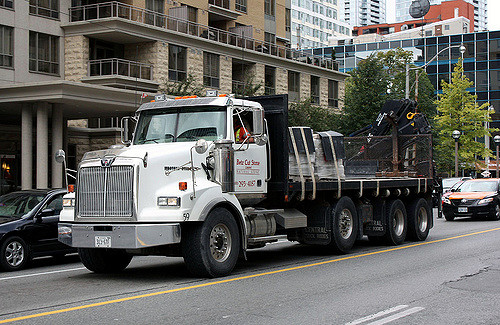At next week’s city council meeting, all eyes are on the councillors’ vote determining the future of the Bloor bike lanes — a decision that will determine whether thousands of people have viable options to get safely and efficiently around their city.
There’s another emerging transportation initiative that is not getting as much attention, but will also have major implications for the efficiency, safety and sustainability of our transportation system: a Freight and Goods Movement Strategy for the City of Toronto. A framework for this strategy was received at Public Works and Infrastructure Committee in October.
If you’re not yet as excited about this as I am, consider the following. Toronto is North America’s fourth most populous city yet has no plan or strategy for goods movement. This puts it out of step with major cities like New York and Seattle, not to mention the neighbouring Region of Peel, who have made serious progress on this front.
Goods movement is an important and growing part of the economy — the Toronto Region Board of Trade has estimated that it contributes $171 billion annually to the GDP of the region — but it also has real impacts on the transportation system, air quality and the environment. Ontario-wide, truck volumes grew by 242% from 1990 to 2014 and heavy-duty trucks alone now produce just under 10% of Ontario’s emissions.
Despite these impacts, we don’t have a strategy for moving goods in Toronto. The Pembina Institute has been calling for such a strategy since 2014 and we think it will help to answer a lot of questions.
For example, the city is planning for denser neighbourhoods along new transit lines and downtown to accommodate its growing population. More people will need to get around by transit, walking and biking for these neighbourhoods to work and the infrastructure will need to reflect this. However, these local residents and businesses will also need access to goods. With this in mind, how should we plan for goods movement in a way that works for everyone in these urbanizing neighbourhoods? A freight strategy would give us a set of principles to lean on, and those principles could be checked against the city’s Complete Streets Guidelines.
Further, growing congestion on downtown streets means that delivery vehicles are stuck in traffic. Are there opportunities for big shippers to drop their goods at consolidation centres, and do the last mile in a smaller vehicle or on a bicycle, or at a different time? Last week’s announcement from UPS that they will test cargo bikes in Toronto is a sign that Toronto is prime for this kind of innovation, which are already proven elsewhere.
Finally, major shifts are happening in the freight sector. To name a few: heavy-duty electric trucks will hit our roads imminently, automated trucks are not far off, and information technology systems offer possibilities unimaginable only five years ago. To be prepared for these trends—and to harness them for benefit—Toronto needs a strategy.
This summer, we surveyed 23 Ontario cities about the challenges they face when planning for freight. From what we heard, we think the following elements would help the City of Toronto’s strategy start on strong footing:
- Data, data, data. It might be surprising to learn that not much is known about how and where trucks are moving on city roads. The city needs to collect, purchase or obtain through partnerships the information needed to make informed decisions.
- Work with industry and other partners to build trust. Businesses hold the key to solutions, but they need to know that the city’s efforts will lead to efficiency gains, not just regulation.
- Break down silos. We heard from many municipalities that within city departments the “freight people” aren’t talking to the “health and climate people.” Since supporting freight efficiency will also support healthy air and reduced greenhouse gas emissions, cities have a lot to gain from working across disciplines and departments.
The next step is securing the funding to start to make the freight strategy a reality — that will be voted on within the 2018-2019 budget process. We sincerely hope the work moves forward and people see the value in a freight strategy. It’s time for Toronto to join other world-class cities in getting serious about sustainable goods movement.





